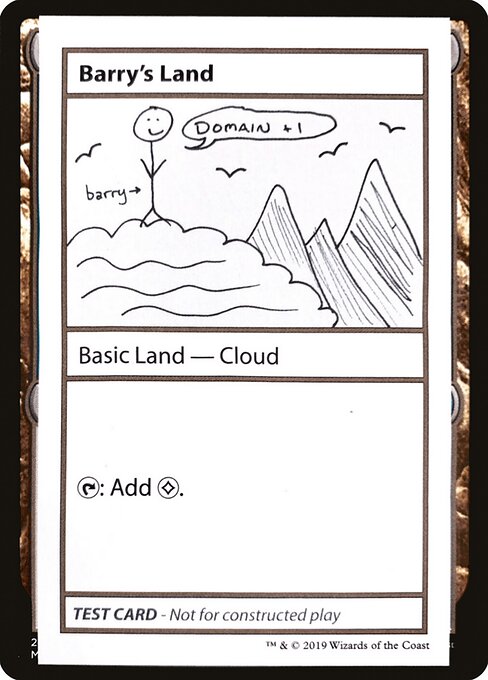
Image courtesy of Scryfall.com
Design adaptation between physical and digital MTG
Magic: The Gathering has always lived in two interwoven realities: the tactile joy of slipping a card from a sleeve and the rapid, data-rich feedback of a digital game. Barry's Land offers a playful gateway into how designers negotiate those two worlds. This Mystery Booster Playtest Card from 2021—Basic Land — Cloud with no mana cost and a single line of text—makes for a perfect case study. It taps for colorless mana, its rarity noted as rare, and it sits within a curious corner of the set that explored art, flavor, and mechanical simplicity during a period when Wizards of the Coast was testing the boundaries of what a “land” could feel like in play and in print 🧙🔥💎. The physical card lands in Mystery Booster Playtest Cards 2021 (cmb2), a reprint of a playful, noncompetitive release, and it carries the aura of a design experiment where form meets function in surprising ways ⚔️🎨.
In physical form, Barry's Land is a reminder that land cards—fundamental, recurring, and often overlooked—can still surprise you. The Cloud subtype evokes air, a soft-edged theme that lends itself to a more atmospheric illustration. The card’s mana cost is intentionally blank; its cmc is 0, highlighting that its power lies in the ability itself: T: Add {C}. This minimalism is where digital designers see an opportunity to improve clarity and accessibility without losing the charm of a card’s lore. In digital spaces, the same card can be rendered with crisp borders, accessible text size, and hover tooltips that spell out the exact mana production in a way that reduces cognitive load during a match 🧙🔥.
Barry's Land also demonstrates how lore and art direction play into design adaptation. Matt Tabak’s illustration—captured in the card’s high-res art—gives the land a tangible personality, even though its mechanical footprint is intentionally understated. In the digital realm, that personality translates into UI decisions: ensuring the art remains legible in various screen sizes, maintaining the subtlety of a borderless cloud theme, and presenting the basic land’s utility in a way that players instantly grasp, whether they’re scrolling through a digital collection or tapping a land drop mid-game 💫.
What Barry’s Land teaches about cross-medium clarity
From a gameplay standpoint, Barry’s Land is a textbook example of design economy—doing a lot with very little. The digital version benefits from:
- Clear, unambiguous text: T: Add {C} is easy to read, even at smaller font sizes on a phone screen.
- Visual fidelity that respects print heritage: the Cloud archetype invites a softer color palette and airy iconography that digital clients can render consistently.
- Accessible information hierarchy: when a match is live, players need to see that this is a basic land and that it produces colorless mana, not a fancy multi-color engine.
- Consistent terminology across formats: basic land, colorless mana, and cloud-themed subtypes align in both physical cards and digital UI so new players can learn quickly and veterans aren’t confused by an unusual frame or symbol.
Meanwhile, in physical print, the tactile dimension remains essential. The choice of a rare playtest card within a Mystery Booster lineup underscores that even the most modest card can carry a story of experimentation, art direction, and collector interest. The market data, with USD prices hovering around a few tenths of a dollar and euros around a bit more, reflects that collectors still chase the rare print run and the curiosity of a playtest label. In digital design, that curiosity translates into onboarding moments—quirks of the card’s rarity and its backstory can be folded into tooltips, splash screens, or collectible badges to enrich the learning curve for new players 🧙🔥🎲.
Practical tips for builders and creators
Designing with this bridge in mind means embracing minimalism where it serves clarity and embracing lore where it adds flavor. For decks built around colorless themes, Barry's Land becomes a compact symbol of a broader strategy: rely on reliable mana from basic lands, then lean into colorless or artifact-based accelerants. For designers, the lesson is to preserve the identity of a land while letting digital UI bring out its personality. Think of how a cloud-like land might fade into the background when you’re counting mana, but pop with a subtle glow during a late-game land drop—enough to remind players of the card’s aesthetic without distracting from the core action ⚔️🎨.
And as we consider cross-platform experiences, the Cypress of digital art meets the taunt of physical rarity. Barry’s Land becomes a conduit for conversations about how far a card can travel—from a high-res painting on a sleeve to a crisp, pixel-perfect interface in a digital client. If you’re a designer, experiment with responsive art crops, ensuring the essential cloud motif remains recognizable whether the card is viewed on a desktop monitor or a compact mobile screen. If you’re a collector or player, appreciate the dual life: a card that’s both a digital UI asset and a piece of physical print history 🧙🔥💎.
MagSafe Card Holder Phone CaseMore from our network
- https://crypto-acolytes.xyz/blog/post/outer-wilds-vs-outer-worlds-which-scifi-adventure-excites-more/
- https://transparent-paper.shop/blog/blog/post/creating-pixel-art-assets-a-guide-for-game-developers/
- https://blog.digital-vault.xyz/blog/post/add-dust-and-scratches-for-realistic-visuals/
- https://crypto-acolytes.xyz/blog/post/mastering-minecraft-armor-trims-styles-colors-and-tips/
- https://blog.digital-vault.xyz/blog/post/grunge-paper-aesthetic-transforming-game-ui-design/